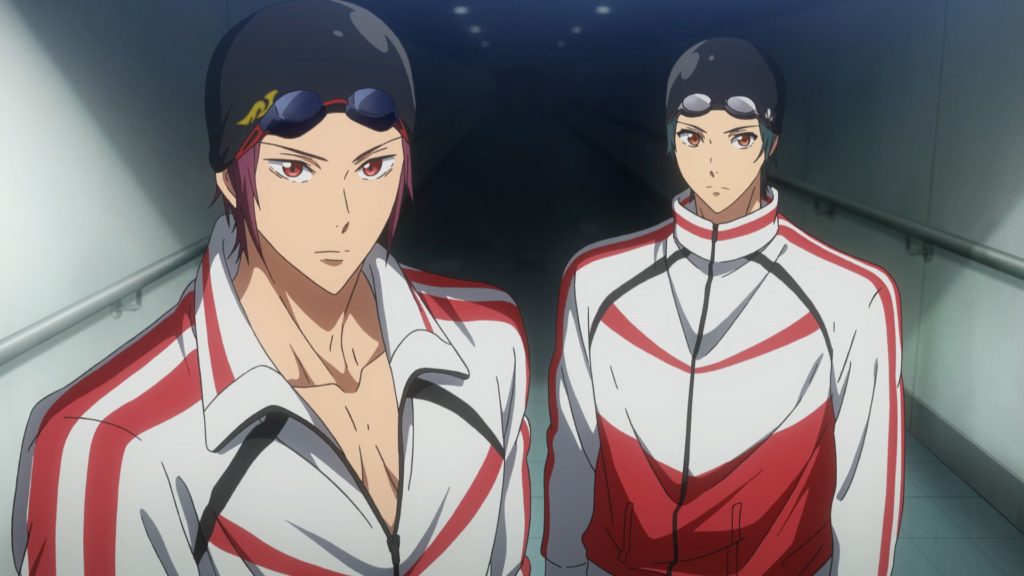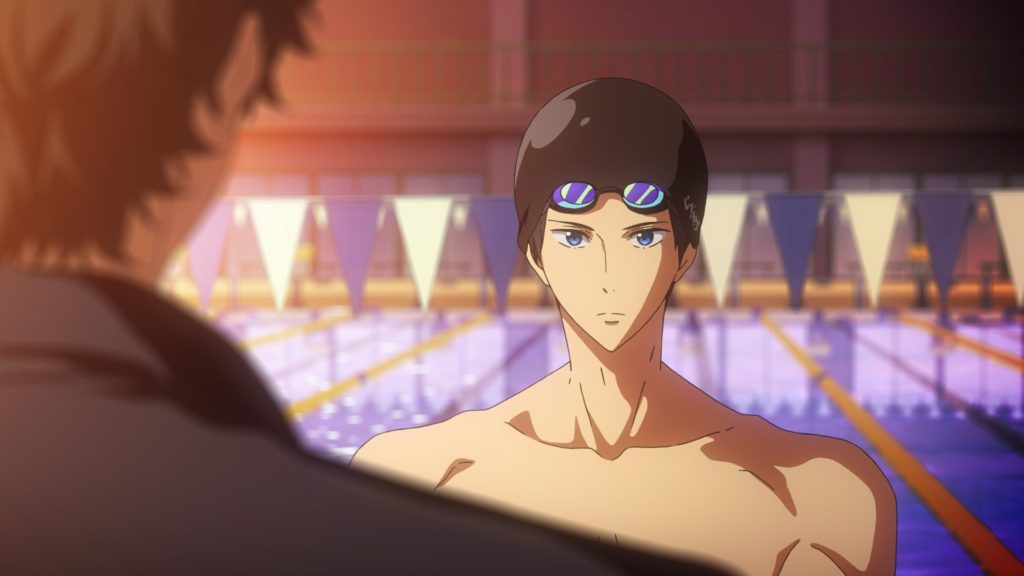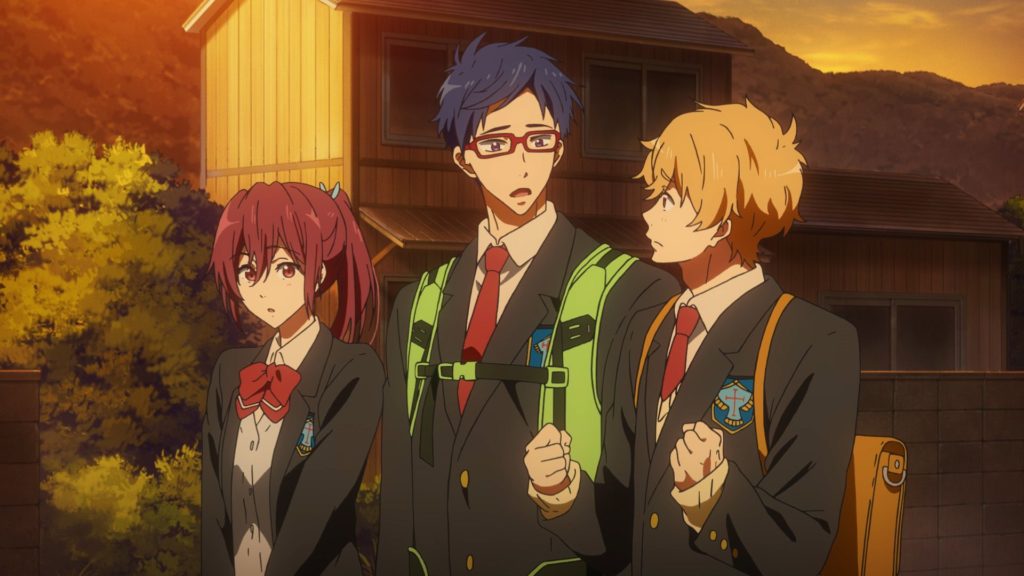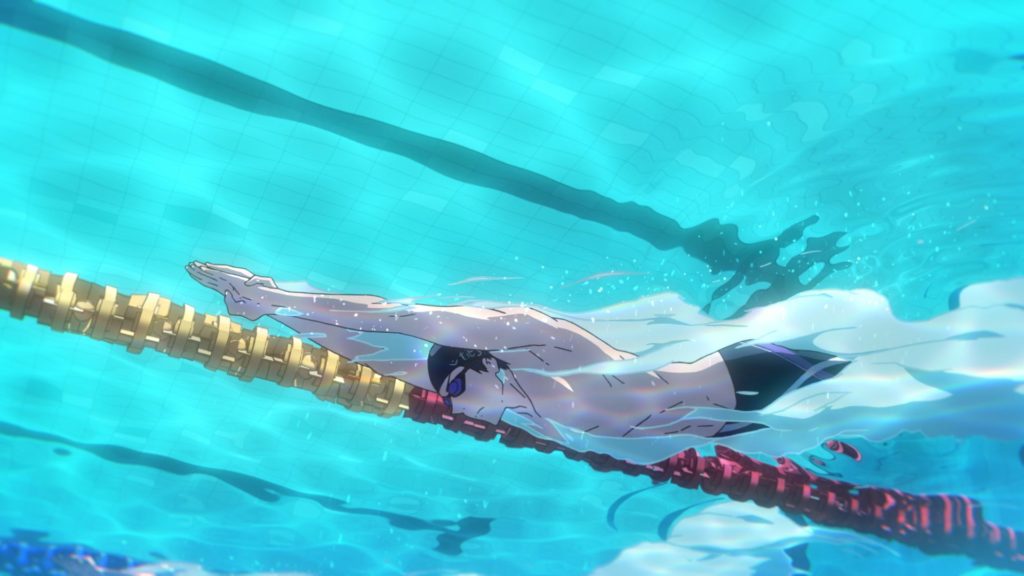Free! – the Final Stroke – the First and Second Volumes Review
In 2013, a fresh and likable TV series from Kyoto Animation captured the hearts of many viewers around the world, bringing us the story of a group of high school boys who love swimming and are determined to revive their school swimming club. Free! Iwatobi Swim Club introduced us to Haru, Makoto, Nagisa, Rei – and Rin. It was engrossing: amusing, dramatic, affecting – and, above all, it created believable and endearing characters. The series was so popular that it inspired two more TV series and several films, following the boys as they grew older, but concentrating most of all on Haruka Nanase, the blue-eyed, mackerel-eating freestyle prodigy.

Volume 1
Now KyoAni have brought out Free! – the Final Stroke – Volumes 1 & 2, two films that follow Haru and several of his contemporaries into the tough world of competitive world-class swimming, starting out with the Sydney Games. Here, he’s pitted against the formidable world champion, Albert Volandel, in the 100 metres freestyle and knows himself to be facing a battle like no other in his life. His feisty friend Rin Matsuoka is also competing in butterfly, as is Ikuya Kirishima who swam a medley with Haru in middle school.

Up until now, Haru has been sustaining his dream with an innate belief in his own love of swimming (love is maybe the wrong word, swimming is his reason for existing). But when Albert quietly throws him the question, “What are you swimming for?” he finds himself at a loss as to how to reply. Where volatile Rin is more than capable of expressing his feelings aloud and doesn’t hesitate to do so, Haru is still the quiet one, keeping everything bottled up deep inside. Nevertheless, all the way through Volume 1, there are telling moments when we’re party to Haru’s thoughts and something that was once said to him that keeps haunting him: “Once you’re over twenty, you’re just an ordinary person.” (In Japan, young people come of age at twenty and are officially considered adults from then on.) Because Haru finds it impossible to share his thoughts and worries, this leads to yet another raw and painful clash with Rin.
Volume 2
Haru’s burning need to find the answer – his answer – to Albert’s question drives him to retreat from his friends, plunging into a relentless and punishing training regime with his coach Ryuji to prepare himself for the next major world-class competition. And stoically choosing this lonely path begins to take its toll. He’s been single-mindedly pursuing his dream for so long – yet could it be that his body is not capable of sustaining him, no matter how hard he trains? Will he even be able to compete against Albert, let alone find an answer to his question?

Free! – the Final Stroke – should delight Free! fans as it generously includes all the characters we’ve come to know (and in some cases love) over the last years. Its director, Eisaku Kawanami, is also responsible for the screenplay and series composition and has directed almost all the other Free! titles. The studio understands its audience well, providing a tense and nail-biting build-up to the Sydney Games in Volume 1, yet sprinkling it with plenty of glimpses of all the other characters who are watching back at home in Japan, from the current swim clubs at both Haru and Rins’ schools to their friends and rivals who didn’t make the cut this time. So if you’re a fan of Rin’s friend, Sousuke, or Momo, who desperately fancies Rin’s sister Gou but hasn’t ever quite got around to telling her – not to mention original Iwatobi members Makoto, Nagisa and Rei, you won’t be disappointed. And their story threads are neatly woven into the main narrative, giving the impression that their lives are ongoing – and that we’re not just being shown the odd little obligatory glimpse to tick boxes. Volume 2 takes this further, building the tension through the interactions between the original Iwatobi team members and their friendly rivals from Samezuka Academy as their mutual concern for Haru grows. However, at times, the desire to satisfy the fans of all the many characters inevitably slows down the action.

When it comes to animation, the way the swimmers move through the water is as convincing and visually pleasing as before; this, after all, was one of the selling points of the original series and it looks great here. The distinctive and attractive character designs by the late Futoshi Nishiya still stand out. The characters are also superbly animated, with as much attention given to fleeting facial expressions (as one would expect from KyoAni) which enrich their interactions as to their fluid movements in the water. The music by Tatsuya Katou, who has composed for all the Free! series and films, is especially effective when underscoring some of the water-based scenes but – again, all credit to the director and team – there are some equally effective and dramatic moments at the pool or in competition in which all that can be heard is the lapping of the water and the harsh gasping for breath of the hard-pressed competitors. It’s rare to be able to praise anime creators for knowing when not to use music to enhance the dramatic impact and this is one of those occasions.

The original voice actors do justice to characters that they’ve now been playing a long time and have come to know well. It seems unfair to pick any one actor out of the team, but Mamoru Miyano is excellent as ever as volatile Rin, Tatsuhisa Suzuki still charms as dependable Makoto and Nobunaga Shimazaki just ‘is’ Haru, imbuing him with the appropriate otherworldly aura. It’s worth mentioning that the enigmatic violet-eyed Albert (played by Jeff Manning) speaks in English throughout. The US subtitle translation is by the ever-reliable Katrina Leonoudakis.
Back in Season 1, much was made of Rin’s sister Gou’s appreciation of the impressive musculature that male swimmers develop and the character designers and animators went out of their way to deliver this to all the viewers who share Gou’s appreciation. Is it fan service? Probably, but it’s hard to participate in competitive swimming and not develop the necessary muscles, so it’s also a realistic depiction.
But what is there to attract viewers coming to these films without having watched the earlier series? There’s no getting away from the fact that they could be confused, given the large number of side characters and flashbacks (even I was at first, as it’s been a while!). It’s not the best place to start, to be honest.

However, Free! fans are in for a treat with this final pair of films that really do justice to a beloved group of characters and deliver some of the most realistic depictions of a sport (swimming) to be seen in an anime. I’m sure that fellow aficionados will also find it difficult to watch some of the more tense and emotional scenes without wiping away a tear or two (I certainly had to reach for the tissues) and it’s good – for once – with an anime to know that the characters haven’t been left in the lurch without a satisfying resolution to their story arcs. An extra fan treat with the credits to Volume 2 is a dazzling sequence of original art stills set to what is said to be OLDCODEX’s last song before disbanding, “This Fading Blue” (they’ve provided all the Free! series OPs and theme songs for all the films). Back in 2013, I couldn’t have imagined being able to watch Free! films in my local cinema in the UK, so thanks are due to Anime Ltd for making this possible – and here’s hoping there might be a box set before too long?
© 2021 Ohji Kouji/Kyoto Animation/Iwatobi Fan ClubFS Production Committee
Check out Anime Ltd’s Free! – the Final Stroke – site to book tickets for the screenings on August 31st 2022.


